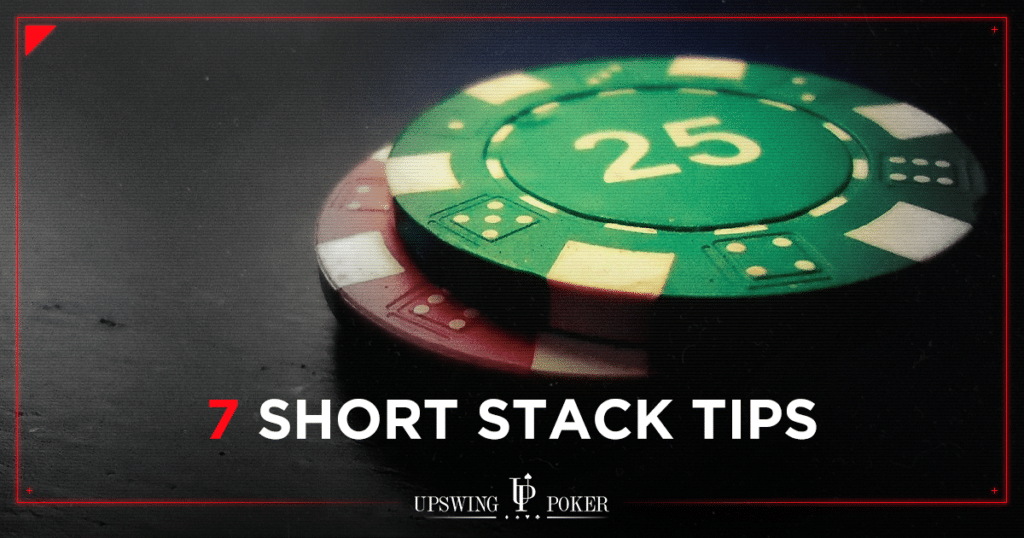Welcome to the exciting world of poker, where skill, strategy, and a bit of luck come together! In this article, we’ll dive into an essential aspect of the game: the Short Stack Strategy. Picture yourself at the poker table with limited chips, and learn how to navigate the game effectively with this unique playing style. Whether you’re a seasoned player or just starting out, understanding the Short Stack Strategy will give you an edge in your poker endeavors.
Imagine you’re playing poker with limited chips, and you find yourself with a short stack. Don’t worry—we’ve got you covered! In this article, we’ll explore the ins and outs of the Short Stack Strategy and how you can make the most of your chip situation. This approach is all about maximizing your opportunities while dealing with limited resources. Get ready to become a poker pro even with a smaller stack of chips!
Ready to level up your poker skills? The Short Stack Strategy is an essential tool to have in your poker arsenal. This strategy focuses on making strategic moves and exploiting your opponents’ weaknesses to turn the odds in your favor. Whether you’re a beginner or a seasoned player, understanding this approach will enhance your poker game. Stay tuned as we delve into the world of poker with limited chips and discover the secrets of the Short Stack Strategy. Let’s get started!
- Play tight and aggressive
- Choose the right hands to go all-in
- Steal blinds whenever possible
- Be mindful of position
- Observe opponents’ tendencies
By implementing these strategies, you can effectively navigate poker games with a short stack and increase your chances of winning.

Short Stack Strategy: Navigating Poker with Limited Chips
Poker can be an exciting and challenging game, and one strategy that players often employ is the short stack strategy. This strategy is used when a player has a limited number of chips compared to their opponents. In this article, we will explore the ins and outs of the short stack strategy, providing you with the information you need to navigate the poker table with confidence, even with a limited chip stack.
1) Understanding the Short Stack Strategy
The short stack strategy is a playing style that focuses on making the most of a limited number of chips. When you have a short stack, you have less room for error and need to be more selective in the hands you play. The goal is to preserve your chips while maximizing your opportunities to accumulate more.
One key aspect of the short stack strategy is to be aggressive in your play. Since you have fewer chips, you can’t afford to wait for premium hands to make a move. Instead, you need to be willing to take calculated risks and make strategic moves to increase your chip count. This might mean making a well-timed bluff or pushing all-in with a strong hand to put pressure on your opponents.
Another important element of the short stack strategy is to be aware of your position at the table. When in early position, you should focus on playing tight and only entering pots with strong hands. However, when in late position, you can open up your range and take advantage of the opportunity to steal blinds and antes.
2) The Benefits of the Short Stack Strategy
The short stack strategy offers several benefits for players. Firstly, it allows you to stay in the game even when you don’t have many chips. By making the most of your limited stack, you give yourself a chance to turn things around and potentially build a solid chip stack.
Additionally, the short stack strategy can put pressure on your opponents. When you make aggressive moves with a short stack, other players may be hesitant to call or raise, fearing that you have a strong hand. This puts you in a favorable position to accumulate chips through well-timed bluffs and strategic plays.
Another advantage of the short stack strategy is that it forces you to play more disciplined poker. Since you can’t afford to make reckless decisions, you are encouraged to carefully assess the value of your hands and make informed choices. This can improve your overall poker skills and help you become a more calculated, strategic player.
3) Tips for Implementing the Short Stack Strategy
When implementing the short stack strategy, there are a few tips to keep in mind to maximize your chances of success.
Firstly, it’s crucial to pay attention to the table dynamics and adjust your strategy accordingly. If you notice that the other players are playing tight and folding frequently, you can take advantage of this by being more aggressive and stealing blinds. However, if the table is loose and players are calling frequently, it may be wise to tighten up and only play strong hands.
Secondly, timing is key when using the short stack strategy. Look for opportune moments to make a move, such as when the blinds are high, and the other players have tight stacks. This can increase their likelihood of folding, giving you a greater chance of success with your strategic plays.
Lastly, don’t be afraid to adapt your strategy as the game progresses. If you manage to double up and increase your chip stack, you may need to adjust your approach and transition to a different playing style. Stay flexible and be willing to make strategic changes based on the evolving dynamics of the table.
Overall, the short stack strategy is a valuable tool in a poker player’s arsenal. By understanding its principles and implementing it effectively, you can navigate the game with confidence, even with a limited number of chips. Remember to be aggressive, stay disciplined, and adapt your strategy as needed. Good luck at the poker table!
Key Takeaways: Short Stack Strategy: Navigating Poker with Limited Chips
- 1. Playing a short stack in poker means having fewer chips, which requires a different strategy.
- 2. Focus on conserving your chips and only play strong hands to maximize your chances of winning.
- 3. Be patient and selective when choosing which hands to play, as you can’t afford to gamble with a limited stack.
- 4. Use your position at the table to your advantage and be aware of your opponents’ playing styles to make better decisions.
- 5. Implement effective bluffing and stealing strategies to stay in the game and gain chips when necessary.
Frequently Asked Questions
Welcome to our FAQ section on Short Stack Strategy in Poker. Whether you’re a novice player or looking to improve your skills, we’ve got you covered. Read on to find answers to some common questions about navigating poker with limited chips.
Q: What is Short Stack Strategy in poker?
A: Short Stack Strategy is an approach used in poker when a player has a limited number of chips compared to the other players at the table. This strategy focuses on maximizing the value of each chip and making precise decisions to stay in the game. It requires a different mindset and adjusting your gameplay to account for having fewer chips.
When employing Short Stack Strategy, players aim to stay involved in hands that have a higher chance of winning. They often play aggressively when they have a strong hand or choose to fold when the odds are not in their favor. The main goal is to accumulate chips and maintain a playable stack to have a chance at winning the game.
Q: How do you determine if you’re in a short stack situation?
A: In poker, being in a short stack situation means that you have considerably fewer chips compared to the average stack size or the chip leader. While the exact definition may vary depending on the specific game or tournament, a general rule of thumb is that if you have 20 big blinds or less, you are considered to be in a short stack situation.
It’s essential to keep an eye on your stack size relative to the other players at the table. Being aware of your position in terms of stack size can help you make more informed decisions and adjust your strategy accordingly. If you find yourself in a short stack situation, it’s crucial to remain patient, play strategically, and seize opportunities to accumulate chips.
Q: What are the key principles of Short Stack Strategy?
A: The key principles of Short Stack Strategy revolve around preservation, patience, and strategic aggression. It’s important to protect your limited number of chips, waiting for favorable hands to make your move. Preserving your stack is essential because it gives you the chance to capitalize on opportunities when they arise.
Patience is also crucial in Short Stack Strategy. It’s essential to wait for strong starting hands or situations where the odds are heavily in your favor. Avoid getting caught up in marginal situations that might endanger your stack. By exercising patience and selecting your battles wisely, you increase your chances of success.
Additionally, strategic aggression is a key element. When you have a strong hand, you want to maximize value by betting aggressively and putting pressure on your opponents. This can force them to make potentially costly mistakes or fold, allowing you to accumulate chips and grow your stack.
Q: How can you exploit the Short Stack Strategy as a player?
A: To exploit the Short Stack Strategy, it’s important to understand the tendencies and limitations of players who are utilizing this strategy. Short stack players often have to make bold moves to accumulate chips or survive in the game, which can create opportunities for other players at the table.
One way to exploit the Short Stack Strategy is to play aggressively against short stack players, putting pressure on them to make difficult decisions. By using their stack size against them, you can potentially force them to fold weaker hands or make mistakes in their decision-making process.
On the other hand, it’s crucial to be cautious when playing against short stack players who employ the strategy effectively. They are aware of their limited chips and may make calculated moves. Always evaluate the situation, assess their skill level, and adjust your strategy accordingly.
Q: Can Short Stack Strategy be effective in tournament play?
A: Yes, Short Stack Strategy can be highly effective in tournament play, especially when you’re facing a lower stack size during the later stages of the tournament. In this stage, where blinds and antes increase, short stack players may adopt this strategy to stay competitive and have a shot at landing a payout.
By implementing Short Stack Strategy in tournaments, players can make the most of their limited chips and conserve their stack until they find the right opportunities to make aggressive moves. However, it’s important to note that strategies may vary depending on the specific tournament structure, prize pool distribution, and the behavior of opponents. Adapting your strategy accordingly is crucial for success.
Short Stack MASTERY Featuring Brock Wilson
Summary
When playing poker with a limited number of chips, it’s important to have a strategy. Start by being patient and waiting for the right opportunities to bet. Don’t be afraid to fold if the odds aren’t in your favor. Stay focused on your opponents’ behavior and adjust your strategy accordingly. Finally, manage your chips wisely by making small bets and conserving your stack. With these tips, you can navigate the game and increase your chances of winning, even with limited chips.
